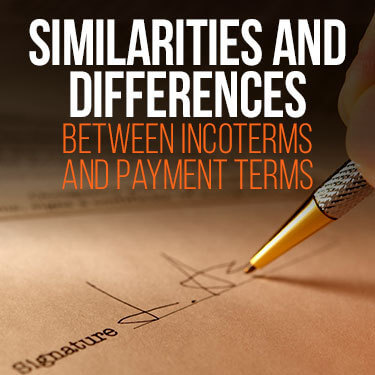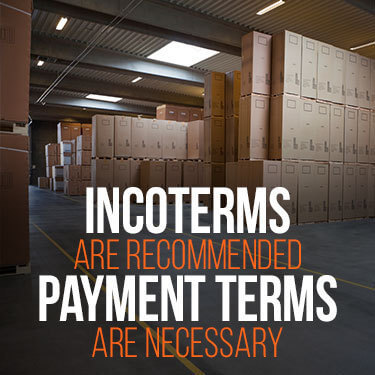
The differences between Incoterms vs payment terms can be hard to differentiate. Even some of the most experienced members of the international trade community get the two mixed up. Despite their similarities, each has its own unique details that differentiate the two and require them to be used in certain situations rather than others.
The difference between Incoterms vs payment terms is the contrast in responsibility between the importer and exporter and when they’re used. Incoterms set the responsibilities of both buyers and sellers throughout the import process. Payment terms set the responsibilities the buyer has to the seller during the payment process.
We’ll explain more about how Incoterms vs payment terms function, as well as other distinctions and similarities that they have.

Incoterms are essentially terms between buyers and sellers. These terms dictate what responsibilities the buyer and seller are responsible for during a transaction. This includes determining who pays for the insurance, who is responsible for paying for the carrier to transport the goods, and who will cover the costs for related import duties and fees.
The International Chamber of Commerce (ICC) created Incoterms as a way to help facilitate healthy global trade between nations. Therefore, Incoterms are internationally accepted by every country.
However, while they’re accepted, sellers and buyers are not required to use them. They’re still extremely helpful whether you’re importing one time only or planning on starting your own import export business.
There are 11 different Incoterms and they’re split into two different categories. Seven of the 11 Incoterms apply to the category that covers any type of shipment. The remaining four are strictly used for shipments that travel by ship.
The seven Incoterms for any mode of transport category are:
The Incoterms for ocean transport only are:
For some Incoterms, the buyer pays for insurance and assumes other costs and risks. Other Incoterms require the seller to handle much of the responsibility required for the shipments. There are also a few different types of Incoterms where both the buyers and the seller share the costs and risks equally.

Our 45 Minute Licensed Expert Consulting Will Personally Guide You.

Payment terms are pretty easy to comprehend. They’re terms that are used to establish the conditions specifically related to the payment of the import. Rather than the seller and buyer negotiating which terms to agree on, the seller is usually the one that dictates the terms that will be used.
Some of these payment terms include:
Each of these payment terms is used for unique situations and can even be beneficial to the buyer as much as they are to the seller. There are numerous types of payment terms, but these are the ones most frequently used for international shipments.
Also referred to as payment in advance (PIA), this form of payment requires the buyer to make their payment before an item is shipped to the port of destination. While paying for an import before it’s even shipped might seem unfair for a buyer, you have to understand the seller's perspective.
When it comes to global trade, sellers and buyers will sometimes have no trading relationship with one another. Therefore, it’s not unreasonable for a seller to fear the possibility of a non-payment for their goods. The cash-in-advance payment term is beneficial for the seller because it protects them from that possibility.
Letters of credit are great because they remove risk from both the buyer and the seller. The bank that the buyer belongs to sends out the letter of credit. The letter states that the buyer will purchase the goods on time and with the correct amount owed to the seller. If the buyer flops on making the payment, the bank will cover the costs in their stead.
Documentary collection is a payment term where both the seller and buyer’s bank handle the payment process. During documentary collection, the seller’s bank will collect payment from the buyer's bank.
Usually, this payment term is used when the seller and buyer already have a trading relationship with one another. One of the benefits of documentary collection is that it’s an easier payment method than a letter of credit or cash advance.
The second type is known as a document against acceptance (D/A). As for the D/A method, the bank allows the buyer to have a credit extension that they can use to pay the seller in the future.
There are two specific types of documentary collections. The first is called a document against payment (D/P). The D/P works by only providing the collection order and shipping documents to the buyer after the buyer has paid the seller.
Open accounts are used by sellers and buyers that have an even stronger relationship between one than buyers and sellers that use documentary collections. With this payment term, the seller ships out their goods to the importer, even if the importer hasn’t paid the full price for the goods.
The seller and buyer negotiate when payment should be completed under this arrangement. These are the different payment lengths they can agree to:
Due to the flexibility of the open account method, the seller is put into a risky situation. This is because there is the possibility that the buyer can not pay for the goods in the allotted time. That said, if the buyer doesn’t fully pay for the goods they’ve imported, they can run the risk of ruining their relationship with the seller.
The last payment, consignment, is the one that is most risky for the seller. Consignment payment terms are used when the seller or supplier sends their goods to the buyer without them actually purchasing it.
In this scenario, the buyer is not required to pay the seller until they have sold the goods they’ve imported. The consignment payment term is often used only by sellers and buyers who have a lasting business relationship.
To better show the level of trust that each payment term carries, we’ve created the table below.
| Payment Term | Level Of Trust |
| Cash In Advance | None |
| Letter Of Credit | Moderate |
| Open Account | Strong |
| Consignment | Lasting |

As outlined above, Incoterms and payment terms have striking differences. That said, they also share a few similarities that cause so many importers and exporters to get confused. Here, we’ll clarify the two types of terms from one another so they’re easier to understand.
One similarity between both Incoterms and payment terms is that both are used to dictate the responsibilities of sellers and buyers. By knowing what their responsibilities are, the seller and the buyer avoid any possible mistakes or misunderstandings between the two.
The difference, however, is what the responsibilities entail for each party. For Incoterms, responsibilities for the entire import process are distributed between both the seller and the buyer. On the other hand, payment terms dictate the responsibility of the buyer, and to some degree, the seller as well. Yet, these responsibilities are strictly for the payment process.
Incoterms allow the buyer and seller an equal amount of bargaining power. That is because Incoterms deal with determining how the goods will get to the other country. Even the most one-sided Incoterms still require the seller and the buyer to put in the effort to negotiate.
Payment terms don’t allow as much negotiation for the buyer. Ultimately, it's the seller with the products and they need to know that they will get paid for the goods they export. While payment terms like open account and consignment are more convenient to the buyer, sellers will typically only agree to these terms if they trust that the buyer will come through.

Incoterms aren’t necessary to use for imports and exports. As helpful as they can be, other terms can be used or negotiated without them involved. On the other hand, payment terms are necessary.
The reason being is that sellers need to have the assurance that they’ll be paid for their goods. Likewise, sellers have different payment preferences and the buyers need to know how to get their funds to them.
A good way to make sure you never confuse Incoterms with payment terms is to schedule a consulting session with a Licensed Customs Broker. They can help you differentiate these two terms from one another.
While Incoterms are not required, they can be an extremely important part of the import process. To learn more, check out our article on the importance of Incoterms.
Unsurprisingly, payment terms are established before the goods are imported. The seller needs to have a firm commitment that the buyer will purchase their goods on their terms. Once it’s determined how the goods will be purchased, the seller and buyer will discuss the Incoterms to determine who will be responsible for what during the rest of the importing process.
At USA Customs Clearance, we can help you get your imported goods through their U.S. port of entry. One of the ways we can give you assistance is through 1-on-1 consulting sessions. During a session, you'll speak with one of our licensed customs brokers and find out what other services are needed for your shipment.
Our customs bond is continuous, which means you will be covered for any number of imports you make in a single year. Lastly, our team is on standby to answer any questions on our contact page. Call us today at (855) 912-0406 to get started.
We guarantee that you’ll import with confidence when you choose USA Customs Clearance.

Our 45 Minute Licensed Expert Consulting Will Personally Guide You.
 Copy URL to Clipboard
Copy URL to Clipboard

Google is changing how it surfaces content. Prioritize our high-quality guides and industry-leading coverage in search results by setting usacustomsclearance.com as a preferred source.
Add your first comment to this post